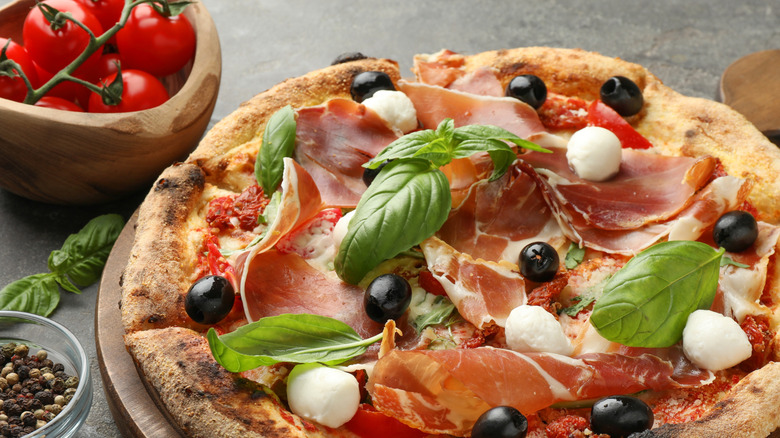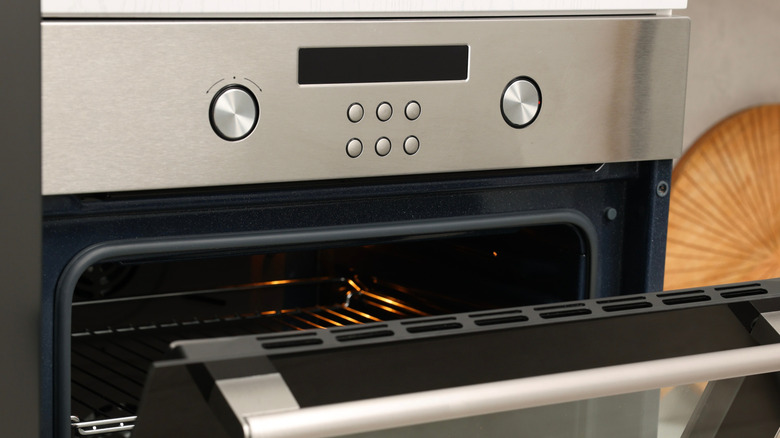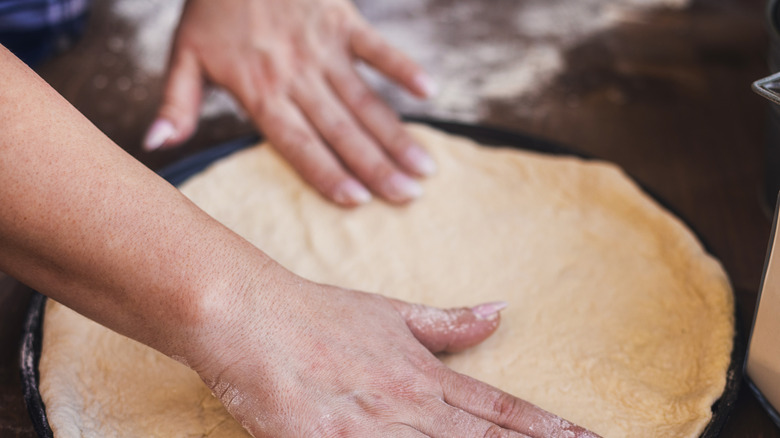Why Pre-Baking The Crust Keeps Ruining Your Homemade Pizza
Homemade pizza was one of those dishes my family stumbled into out of necessity. We have a designated "pizza day" and we adhere to it religiously, or else face the grumblings of disappointed children. Let's just say one day we couldn't get the pizza we wanted, so we had to call an audible because the show must go on. Homemade pizza just made sense — it was delicious and, as an added bonus, the kids regarded us as rockstars (at least for a moment) for saving the day.
Now that we've left off ordering pizza and stuck with the homemade variety for the time being, we've had the chance to learn from our mistakes through trial and error on our way to perfecting the process. Now I can also share with others one reason why their crust always comes out too tough or dry: Pre-baking the crust, a common tip meant to prevent soggy centers.
Though it sounds logical to bake the dough partway first, especially if you're worried about raw spots, this can sometimes do more harm than good, so don't complicate a simple homemade pizza by adding this unnecessary step. A properly made homemade pizza crust should be chewy on the inside, slightly crisp on the outside, and strong enough to hold toppings without turning into a cracker. When you pre-bake, you risk over-drying the dough, especially around the edges, which can lead to a disappointing bite even before the toppings come into play. It's definitely one of many mistakes you want to avoid when making homemade pizza.
A hot oven is more important than a head start
One of the biggest reasons people turn to pre-baking is fear that their crust won't fully cook underneath all those toppings. That's understandable, but it usually signals that your oven isn't hot enough. "Most pizzas will cook in about six to eight minutes at 500 to 550 degrees Fahrenheit," James King, complex executive chef for Hilton Tampa Downtown and Embassy Suites Tampa Downtown Convention Center, previously told The Takeout. He went on to remind us to "just keep an eye on the crust and cheese — you're looking for a bubbly top and golden edges."
This temperature helps replicate the kind of fast, high-heat environment that pizza dough thrives in. If your oven is too cool, the toppings cook before the crust has time to rise and brown properly, tempting you to par-bake the dough ahead of time. The thing is, when the dough starts baking on its own before the sauce, fresh mozzarella cheese, and other toppings are added, it loses moisture. By the time you put it back in the oven for round two, you're not working with fresh dough anymore; you're essentially toasting it, and you end up with a crust that's hard instead of tender. If you're using a pizza stone or steel, let it heat for at least 30 minutes before baking. That intense, direct heat helps cook the crust from the bottom up, giving you that satisfying chew without the dry crunch. Interestingly enough, you don't even need an oven to make a homemade pizza — but that's a different story for a different day.
When pre-baking actually makes sense (and how to do it right)
There are a few cases where pre-baking the crust does have a place, but it's more of an exception than a rule. For example, if you're using a particularly wet sauce, a gluten-free dough, or a pizza that's going to be loaded with heavy toppings, such as lots of vegetables or meat, a short pre-bake can help keep the center from getting soggy. The trick is not to overdo it. You want the dough to firm up slightly — not to become rigid or golden.
To do it right, pre-bake the crust for just three to five minutes, ideally on a hot stone or a perforated pizza pan. As soon as the dough loses that raw, sticky feel — but hasn't yet taken on any browning — it's time to pull it out. Then you can add your sauce and toppings and return it to the oven to finish baking all at once. This way, the crust gets another shot at rising with the toppings, and you avoid ending up with a pizza that's crispy for all the wrong reasons. Just a little something everyone needs to learn about homemade pizza. So, before you automatically reach for that pre-bake step next time, consider your setup — and your dough. Most of the time, a high-heat oven and proper timing gives you the pizza results you're after. No shortcuts needed.


